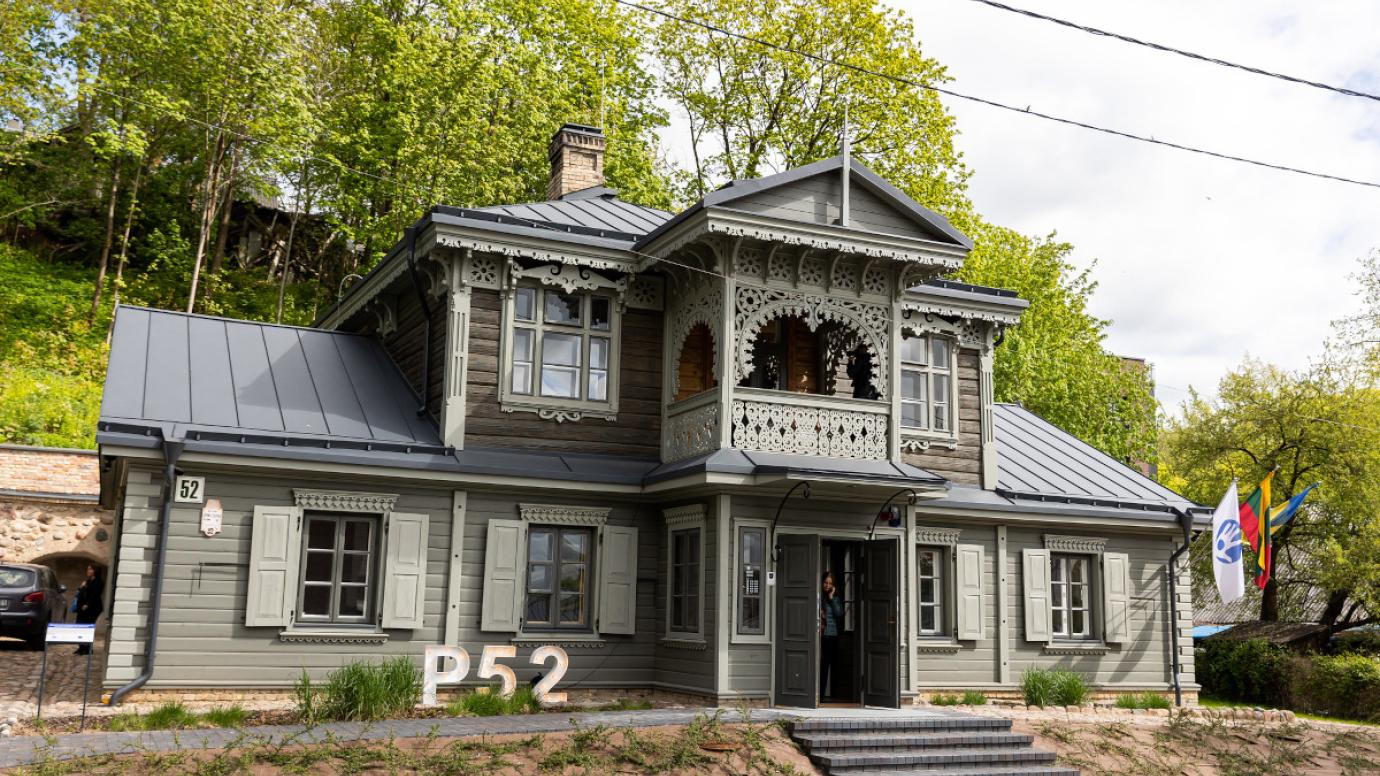Vilnius: Museum of Urban Wooden Architecture
Reviving traditional techniques for an environmentally friendly city.
- Country:
-
 Lithuania
Lithuania
- Type of project :
- Cultural facility
- Heritage
- Size of city/region:
- 200 000 inhabitants to 1 million inhabitants

Key facts
Architecture studios: JSC Vilniaus Planas
Main sponsor: Vilnius city municipality
Year completed: 2022
Materials: wood
Total area: 1281 m2
Usable floor area 242 m2
Prizes: European Heritage Award 2022
City / regional background
Vilnius has defined “10 principles for quality architecture in Vilnius” that are important for the shaping of the future image of the city and its quality of life. Two of these principles intend to preserve and reuse historic buildings and heritage objects and invites to develop the city in a more sustainable way.
Užupis, the oldest historical suburb of Vilnius, was defined a priority area in the Vilnius City Master plan and Vilnius Old Town management plan. It features a great example of wooden architectural heritage: the house at Polocko Street 52. Considered one of the most beautiful historical wooden buildings in Vilnius, it was abandoned for decades, leading to its significant deterioration.
However, in 2019 Vilnius City Municipality decided to restore the building and establish a new cultural institution - the Museum of Urban Wooden Architecture (MUWA) as a cultural infrastructure meeting the needs of contemporary society.
Solution
Built in the 19. century, the house is an example of wooden urban architecture with unparalleled carvings on the facade.
The restoration works, carried out by an interdisciplinary team of woodworkers, polychrome researchers, and restorers, aimed to preserve the building’s authenticity. 80% of the original exterior decoration elements and 70% of the authentic walls and structures were retained. To reduce the use of new materials, the team used elements from other demolished wooden buildings when those from the original house could not be saved.
The interior wall decoration was preserved and partially restored in accordance with polychrome research results.
The MUWA promotes wooden architecture as a sustainable, environmentally friendly solution, and integral part of the contemporary city. The museum presents an exhibition which connects the past, present and future of urban wooden architecture in the world, as well as works by local artists, and by students and graduates of the Vilnius Academy of Arts.
It also established a consultation centre with a database of craftspeople to help owners and residents of wooden buildings in Vilnius learn how to maintain and preserve their homes in a way that is sustainable and historically sensitive.
The renovation of the house inspired a similar project in Šnipiškės, another suburb of Vilnius, where an experimental hub of historic and contemporary wooden architecture is planned.
Criteria for high-quality (context, sense of place, diversity, beauty)
With the Museum of Urban Wooden Architecture, the city has managed a sustainable restoration and rebranding of a historical wooden house, setting an example for the country and wider Baltic region.
The museum activities contribute to raising awareness about the aesthetics and contemporary use of wooden architecture heritage among residents and visitors, bringing historic timber-based buildings back into the cityscape.
The museum has published a catalogue of the original elements of wooden architecture in Vilnius and organised two international conferences: for contemporary wooden architecture (2022) and for wooden architecture heritage in cities (2023).
Since its opening, the museum has become a meeting point for the people of the district. The consultation centre has already helped around 100 citizens with the maintenance and restoration of wooden buildings.
From an artistic point of view, the house features authentic materials and forms from the late 19th century. Its unique decoration distinguishes it from other residential wooden buildings of the time, giving it the character of a suburban residence.
The museum is an in situ preserved example of the heritage of wooden architecture that strengthens the visual identity of Užupis, and is a recognisable and much-loved place by Vilnius residents.
Planning and management
6 representatives from Vilnius City Municipality from Department for Culture, Department for Cultural heritage preservation, Department for Project Management.
Director of Directorate of Vilnius Memorial Museums
3 staff members from the Museum of Urban Wooden Architecture.
Technical supervision was provided by the company JSC Vilniaus vystymo kompanija.
Budget and financing
The total value of the project is €1 183 597 of which €506 991,18 funded by the European Union (Priority 7 "Promotion of quality employment and participation in the labour market" of the European Union funds investment action programme), €676 606,63 funded by the Vilnius City Municipality.
Transferable ideas
- Invest significant time and resources in documentation and research. including architectural assessments, archival research and on-site surveys. This will ensure that the project aligns with the building's original design and cultural significance.
- Establish partnerships with skilled craftspeople and heritage experts who possess cultural heritage preservation certificates and expertise in traditional building and crafting technologies to maintain authenticity during restoration.
- Prioritize sustainability and authenticity: in the use of existing materials and minimize the introduction of new elements. Strive to strike a balance between preservation and modern requirements, ensuring that the building remains functional while staying true to its historical and cultural roots.
Contact information
Contact the Museum of Urban Wooden Architecture via email.


